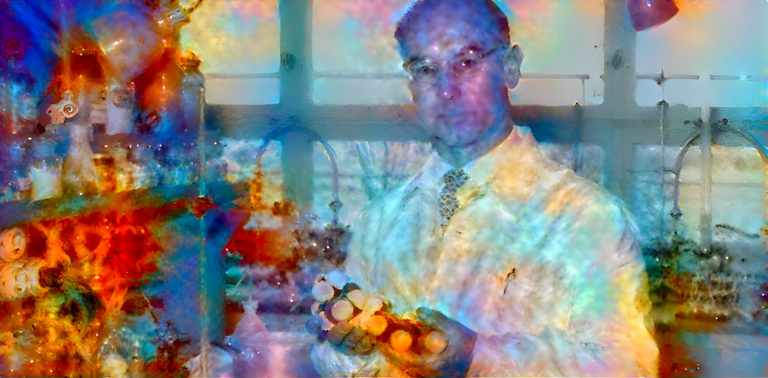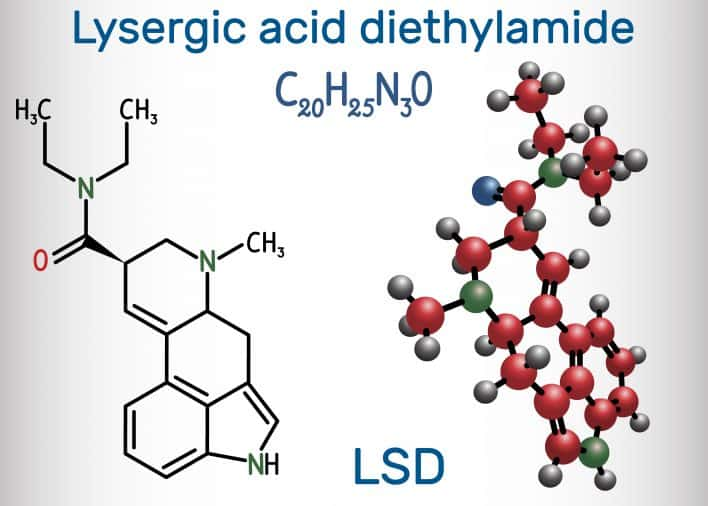Dr. Albert Hoffman - The Father of Psychedelics

Image created using Deep Dream Generator
Dr. Albert Hoffman was a Swiss chemist born in 1906. He became interested in chemistry as a young boy and attended the University of Zurich to study chemistry. After completing his PhD he began his career as an organic chemist and eventually became the director of research for Sandoz Pharmaceuticals, now called Novartis.
Hoffman studied chemicals in Ergot, a deadly fungus found in tainted rye responsible for hundreds of thousands of deaths throughout history. He was in search of chemicals that could be used as circulatory and respiratory stimulants after one of his predecessors isolated chemicals that were useful in childbirth. He created a process to synthesize the organic compounds in ergot, all based on lysergic acid, from their component chemicals.
The chemist went on to synthesize a wide array of compounds based on lysergic acid. This included novel chemicals like the now infamous Lysergic Acid Diethylamide, better known as LSD.
In April of 1943, while World War II raged not so far away, Hoffman was working in his lab when all of a sudden he felt dizzy and strange, leaving work for the day and writing a memo to his boss stating:
I was forced to interrupt my work in the laboratory in the middle of the afternoon and proceed home, being affected by a remarkable restlessness, combined with a slight dizziness. At home I lay down and sank into a not unpleasant intoxicated-like condition, characterized by an extremely stimulated imagination. In a dream-like state, with eyes closed (I found the daylight to be unpleasantly glaring), I perceived an uninterrupted steam of fantastic pictures, extraordinary shapes with intense, kaleidoscopic play of colors.
He wasn’t entirely positive at first what had caused the episode. After intentionally breathing in fumes of a chloroform-like chemical to rule it out, he suspected he may have been exposed to an incredibly small amount of LSD.
Lysergic Acid Diethylamide (C20H25N3O)

Image Source: ReAgent
LSD is a psychedelic drug of the ergoline family that induces powerful and unpredictable hallucinations. It is one of the most potent hallucinogens known to man with a dose as small as 25 micrograms capable of causing a user to experience intense and profound hallucinations.
LSD works by binding with serotonin receptors in the brain which are involved in thought processes, mood, appetite, and physical sensations. This causes an increased release of serotonin and a subsequent and drastic alteration in perceptions and mood.
LSD’s most prominent effects are visuals and hallucinations. It is a potent physical and mental stimulant that causes an intertwined euphoria and introspection.
April 19th - Bicycle Day
A few days later when he returned to his lab he would look over his work and make a decision that would affect the consciousness of millions of people over the coming decades.
In previous experiments, he’d given rabbits and other animals doses of 10-50 micrograms/kg without any observed effect over time. With this information decided — without telling anyone at the lab save his assistant — to try a much higher dose of 250 micrograms… on himself. He was actually expecting it to do nothing at all, but he was very pleasantly mistaken!
He wrote a single entry in his journal for the experiment about 40 minutes after ingesting the chemical:
17:00: Beginning dizziness, feeling of anxiety, visual distortions, symptoms of paralysis, desire to laugh.
April 19th is a special day for many, as it marks the anniversary of the day that Albert Hoffman took his first dose of LSD and experienced the very first full-blown acid trip.

Image created using Deep Dream Generator
He asked his lab assistant to escort him home, but because of wartime restrictions, they were forced to make the trip on bicycles. He later described the event from which this unofficial holiday of sorts gained its name in a memoir stating “Everything in my field of vision wavered and was distorted as if seen in a curved mirror. I also had the sensation of being unable to move from the spot.”
They soon arrived at his home safely and his assistant was asked to call the doctor. The powerful hallucinogen he was under the influence of scared the hell out of him. Filled with anxiety and regret, he wasn’t sure whether his mental faculties would return to normal, or even if his decision would ultimately lead to his death.
Upon arrival, the doctor found nothing “wrong” with Hoffman aside from dilated pupils. His blood pressure, pulse, and respiration were all fine and he was essentially told to sleep it off. He later wrote:
The horror softened and gave way to a feeling of good fortune and gratitude, the more normal perceptions and thoughts returned, and I became more confident that the danger of insanity was conclusively past.
Now, little by little, I could begin to enjoy the unprecedented colors and plays of shapes that persisted behind my closed eyes. Kaleidoscopic, fantastic images surged in on me…
Why let an accidental brush with ego-death stop you?
Hoffman took a small, albeit short-lived, step back and began testing the chemical on animals to determine any toxic effects. None of the animals showed signs of acute harm from the tests, and Hoffman would eventually decide to informally continue his research “in the friendly and private company of two good friends.”
He talked many times about his experiences over the years. Sometimes he would experience feelings of euphoria and a “unity with all creatures in the universe.” Other times, despite controlling his settings and beginning with thoughts of positivity and high spirits, he still experienced deep depression while under the influence of LSD.
Drugs can be dangerous (a disclaimer)
The unpredictability of drugs is something to take very seriously. This article should in no way be construed as condoning the use of any illegal substance and is purely for educational and entertainment purposes.
Albert Hoffman was kind of insane for experimenting with LSD the way he did, but it did lead to our expansion of knowledge. Over the past few decades, Lysergic Acid Diethylamide has been used in the treatment of anxiety, depression, psychosomatic diseases and addiction.
References:
https://www.theatlantic.com/health/archive/2014/09/the-accidental-discovery-of-lsd/379564/
https://www.frontiersin.org/articles/10.3389/fpsyt.2019.00943/full
Thanks for Reading!

What a science hero!
I think many major breakthroughs in science happened by serendipity. This is quite an interesting read. It's been a while.
Thanks for your contribution to the STEMsocial community. Feel free to join us on discord to get to know the rest of us!
Please consider supporting our funding proposal, approving our witness (@stem.witness) or delegating to the @stemsocial account (for some ROI).
Please consider using the STEMsocial app
app and including @stemsocial as a beneficiary to get a stronger support.
Your level lowered and you are now a Red Fish!@thatsweeneyguy, sorry to see you have less Hive Power.
Check out the last post from @hivebuzz:
Support the HiveBuzz project. Vote for our proposal!